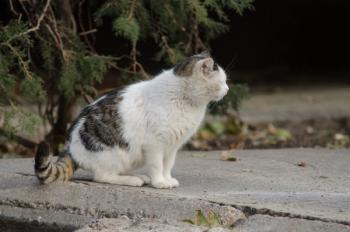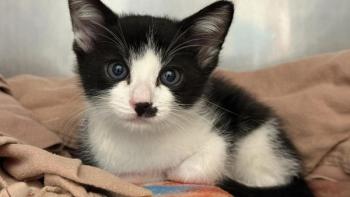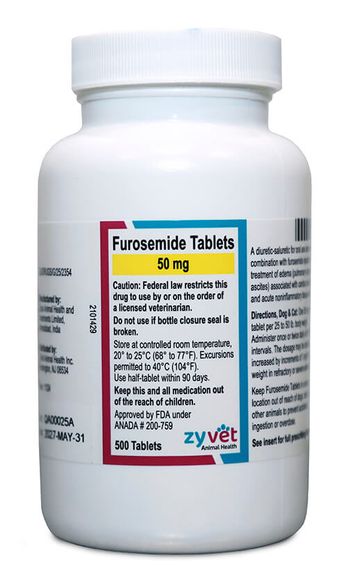
Common hazards for cats (Proceedings)
Permethrin, a synthetic type I pyrethroid, is found in many flea and tick shampoos, dips, foggers, spot-ons, and sprays as well as many household and yard insecticide formulations. While permethrins have a relatively wide margin of safety in dogs, cats appear to be more sensitive to the toxicity of some concentrated pyrethroids, particularly permethrin.
Permethrin
Permethrin, a synthetic type I pyrethroid, is found in many flea and tick shampoos, dips, foggers, spot-ons, and sprays as well as many household and yard insecticide formulations. While permethrins have a relatively wide margin of safety in dogs, cats appear to be more sensitive to the toxicity of some concentrated pyrethroids, particularly permethrin. The low-concentration products (sprays, foggers) approved for use on cats or in household premise sprays generally contain 0.05–0.1% permethrin and do not cause clinical syndrome that has been associated with the inappropriate use of concentrated products on cats (i.e. undiluted 15% dips, 45–65% permethrin spot-ons). Permethrin toxicosis usually occurs when a concentrated dog product is applied to cats, but cats that actively groom on or engage in close physical contact with recently treated dogs may also be at risk of toxic exposure. Clinical signs of permethrin toxicosis in cats include hypersalivation, depression, ear twitching, facial twitching, generalized muscle tremors or fasciculations, hyperesthesia, hyperthermia, vomiting, anorexia, convulsions, and possibly death. Onset of clinical signs is usually within a few hours of exposure but may be delayed up to 24 hours. The severity of clinical signs often varies significantly among individual cats exposed to similar amounts of permethrin, with some cats developing only mild fasciculations while others develop life-threatening signs.
Treatment of permethrin toxicosis should include control of tremors, supportive care, and decontamination. Methocarbamol (50–150 mg/kg slow IV; do not exceed 330 mg/kg/day) is preferred to control the tremors. If no injectable methocarbamol is available, the oral form may be dissolved in water and administered rectally. If the cat is actively convulsing and methocarbamol is ineffective, propofol, inhalant anesthetics, or barbiturates may be needed. Given alone, diazepam may actually exacerbate the tremors, but once methocarbamol has been used to reduce the tremor activity, diazepam (0.1-0.5 mg/kg) may be helpful at reducing hyperesthesia. The use of atropine is not indicated in pyrethroid exposures and should be avoided. Once tremors are under control, cats should be bathed to remove the product from the haircoat and skin. Liquid dishwashing soap (e.g. Dawn) should be used to bathe the entire cat. Thermoregulation is very important in these cases, as tremoring cats often present hyperthermic only to develop hypothermia following tremor control and bathing. Hypothermic cats may experience recrudescence of tremors as well as decreased metabolism of the permethrin due to decreased metabolic rate. Permethrins appear to have no direct action on the liver or kidneys, but fluids may be helpful in protecting the kidneys from myoglobin breakdown products in severely tremoring or convulsing cats. Potential complications to permethrin toxicosis in cats include disseminated intravascular coagulopathy and rhabdomyolysis due to prolonged seizuring and/or hyperthermia. The prognosis for mildly tremoring cats is usually good, but treatment may be required for up to 24–48 hours. The prognosis for severely affected cats is guarded, although many of these will make full recoveries if given aggressive veterinary care.
Etofenprox
Etofenprox is a synthetic non-ester pyrethroid. Although some manufacturers will claim it is not a pyrethroid because it lacks an ester moiety found in most other pyrethroids, etofenprox shares much structural and, more importantly, functional characteristerics of the pyrethroids. Spot-on formulations containing 40-55% etofenprox have been approved for use on cats. Most cats tolerate etofenprox well, but a small percentage of cats will develop signs similar to permethrin toxicosis after administration of the product per label directions. Usually the signs from etofenprox toxicosis in cats are much milder and do not last as long as permethrin toxicosis; in rare instances severe signs may be seen. The clinical signs and management of etofenprox toxicosis in cats is the same as for permethrin toxicosis, with methocarbamol generally working quite well to resolve the mild to moderate tremors. The prognosis for etofenprox toxicosis is generally quite good, and many cats experience no more than mild fasciculations which resolve following bathing. Adverse reactions to products that have been used appropriately (per label) should be reported back to the manufacturer and/or appropriate government regulatory agency. Adverse reactions to appropriately used pesticides may be reported to the EPA via the National Pesticide Information Center (NPIC) at 1-800-858-7378.
Lily
Easter lilies (Lilium longiflorum), tiger lilies (Lilium tigrinum), rubrum or Japanese showy lilies (Lilium speciosum and Lilium lancifolium), and various day lilies (Hemerocallis species) have been incriminated in causing acute renal failure and death in cats. The toxic principle is unknown. Even minor exposures (a few bites on a leaf, ingestion of pollen, etc.) may result in toxicosis, so all feline exposures to lilies should be considered potentially life-threatening and should merit aggressive clinical intervention. It should be noted that not all plants with "lily" in the name are members of Liliaceae, e.g. calla lily (Zantedeschia spp., which are insoluble oxalate-containing plants) or lily of the valley (Convallaria spp., which are cardiac glycoside-containing plants).
Affected cats often vomit within a few hours of exposure to lilies, but the vomiting often subsides after a few hours, during which time the cats may appear normal or may be mildly depressed and anorexic. Within 24 to 72 hours of ingestion, oliguric to anuric renal failure develops, accompanied by vomiting, depression, anorexia, dehydration, and hypothermia; additionally, disorientation, ataxia, facial and paw edema, dyspnea, and seizures have been less commonly reported.
Elevations in blood urea nitrogen (BUN), creatinine, phosphorus and potassium are detectable as early as 12 hours post ingestion. Creatinine elevations usually precede other lab abnormalities and may be especially striking, with levels as high as 44 mg/dl reported. In some cases, hypoglycemia and mild liver enzyme elevations may occur. Abundant casts, proteinuria, glucosuria, and isosthenuria are usually detectable on urinalysis within 24 hours of ingestion, reflecting lily-induced damage to renal tubular cells. In severe cases, death or euthanasia due to acute renal failure generally occurs within 3 to 6 days of ingestion.
When initiated within 18 hours of ingestion, decontamination (emesis, oral activated charcoal, and cathartic) and fluid diuresis using balanced crystalloid solutions at twice maintenance infusion rate for 48 hours have been effective in preventing or minimizing lily-induced acute renal failure. Conversely, delaying treatment beyond 18 hours frequently results in death or euthanasia due to severe renal failure. Baseline renal values should be obtained upon presentation and then repeated at 12, 24, 36 and 48 hours; if no abnormalities at 48 hours, cats can be weaned off the fluids and final renal values repeated prior to discharge.
Because the tubular injury from lily ingestion spares the renal tubular basement membrane, regeneration of damaged tubules may be possible. In cases with severe oliguria or anuria, Hemodialysis (if available) or peritoneal dialysis may aid in managing renal failure until tubular regeneration occurs (10-14 days or longer).
Ethylene glycol
Ethylene glycol is most commonly thought of as automotive radiator antifreeze, but ethylene glycol is also present in high concentrations in many brake fluids and aircraft deicers. In addition, ethylene glycol is often used in condensers, heat exchangers, home solar units and portable basketball goal post bases. Ethylene glycol may also be used to winterize toilets in recreational vehicles and summer homes in colder latitudes. Ethylene glycol is commonly present as a component in household paints, but it is rarely present in concentrations above 10% and significant ethylene glycol exposure is unlikely unless very large quantities of paint are ingested. Inks, ink pad, polishes, finger moistening compounds (e.g. Tacky Finger®), and other stationery supplies may contain ethylene glycol. Some ink pens contain relatively high levels of ethylene glycol, but the total volume of ink is only a few milliliters, so ink pens would only pose an ethylene glycol risk to very small animals such as cats less than 2-3 pounds.
Relative sensitivity of different species to ethylene glycol
Unfortunately, reliable toxic doses of ethylene glycol have not been established for most animals, including cats. Much of the acute toxicity data available is based on doses that cause early deaths from acidosis/intoxication and do not take into account the fact that many animals may survive the initial stages of toxicosis only to succumb to kidney failure days later. Because of this, any suspected oral exposure of a cat to radiator antifreeze should be considered a potential toxicosis, and steps should be taken, through historical and diagnostic information, to attempt to determine the extent of the exposure. When doubt still exists, the only prudent recourse is to treat as if the ingestion was potentially toxic.
Ethylene glycol is a very potent alcohol and many of the early signs of ethylene glycol toxicosis will relate to severe alcohol intoxication. In addition, ethylene glycol is broken down to metabolites (e.g. oxalic acid) that cause acidosis and damage the kidney tubules, resulting in renal failure. Because of the different mechanisms involved in ethylene glycol toxicosis, clinical signs frequently change throughout the course of the toxicosis. It is sometimes easier to break the clinical signs noted into 3 different stages, although considerable overlap between these stages may be seen and some animals will not experience each stage; death can occur at any stage. The stages are 1) neurologic—the initial inebriation due to the effects of alcohol on the CNS, 2) cardiopulmonary—due to severe acidosis and electrolyte disturbances, and 3) renal—due to renal tubular injury from calcium oxalate crystals.
Stage 1—Neurologic. Generally begins within 30 minutes of exposure and lasts up to 12 hours. In mild to moderate cases, this stage may pass quickly and may not be noted by the cat owner or veterinary staff. Cats may be initially ataxic, disoriented, "drunk," stuporous, hypothermic (especially cats), polyuric, and polydipsic (PD/PU more pronounced in dogs). Coma and death may occur during this stage, or the cat may appear to partially or fully recover over 3-6 hours. By 6-12 hours, the neurologic status of the cat may again deteriorate due to development of severe metabolic acidosis from ethylene glycol metabolites. Usually see marked CNS depression, stupor or coma. Seizures are possible.
Stage 2—Cardiopulmonary. Generally from 12 to 24 hours following exposure. Signs may be more recognizable in dogs than cats. Tachypnea, tachycardia, depression, ± seizures, and pulmonary edema may occur. At this time, a high anion gap and severe metabolic acidosis are generally present.
Stage 3—Oliguric renal failure. Can be seen as early as 12 hours in cats, but generally within 24-72 hours following exposure. Azotemia, depression, anorexia, vomiting, abdominal pain, oral ulcers, and oliguria progressing to anuria. Low urine specific gravity, glucosuria, may see calcium oxalate crystals in urine (absence of crystalluria does NOT rule out the possibility of EG toxicosis, as it appears late in the toxicosis and is only present in about 40% of cases of EG toxicosis). Seizures are possible.
Clinical pathologic abnormalities include increased osmolal gap and anion gap, hyperglycemia, hyperkalemia, decreased blood pH, and hypocalcemia. BUN and creatinine become elevated but usually not before 12 hours post exposure; therefore BUN and creatinine are of minimal benefit in diagnosing early exposures.
Diagnosis is based on history, clinical signs, and confirmatory laboratory testing. Cats are much more sensitive than dogs to ethylene glycol and may develop toxicosis at levels well below the level of detection of the long-established (PRN) ethylene glycol test kit used for dogs. So for this kit, while a positive test result in a cat is significant, a negative test result does not rule out the potential for toxicosis. Two newer ethylene glycol tests for dogs and cats (REACT and KAYCEE) have recently been put on the market, but there appears to be a high propensity for these to give false positives, especially when testing cats. Because of this, while a negative result is likely to be believable, a positive result should be suspect without other corroborating evidence of EG exposure. For cats, a more reliable means of diagnosing ethylene glycol exposure would entail having ethylene glycol levels run at a human hospital on a STAT basis. Many human hospitals are willing to do this, although sometimes it takes talking to the laboratory technician rather than a receptionist. In cats, values over 20 mg/dL are considered in the toxic range and would merit treatment. Measuring anion gap (>25 mEq/L) or serum osmolality (> 20 mOsm/kg) may assist in diagnosing ethylene glycol toxicosis. Observation, via Wood's lamp, of fluorescence in urine, stomach contents or on paws/muzzle may suggest exposure (fluorescein dye is added to automotive antifreeze to help in detecting radiator leaks).
Treatment of ethylene glycol toxicosis must be timely and aggressive. Failure to institute appropriate therapy within the first several hours may result in irreversible renal damage or death of the cat. For recent (within 30 minutes) exposures and asymptomatic cats that have not already vomited, induce vomiting or perform gastric lavage; because food in the stomach may slow absorption, emesis or lavage may be of benefit up to 1 hour in cats that have recently eaten. The use of activated charcoal is somewhat controversial, as aliphatic alcohols are not thought to be well adsorbed by charcoal, but many clinicians routinely use activated charcoal in ethylene glycol exposures. Based on exposure history and/or diagnostic test results, the use of either fomepizole or ethanol infusion (see below) may be indicated.
Symptomatic cats should be stabilized as needed. Seizures can be controlled with diazepam or barbiturates, but care must be taken to minimize any further CNS depression. Intravenous fluids therapy is the cornerstone of treatment, especially in symptomatic cats. High infusion rates of crystalloids are necessary to correct dehydration and hypoperfusion; fluid ins and outs should be monitored to avoid fluid overload and possibly pulmonary edema. Treatment of acidosis and renal failure may be required. Oliguric or anuric cats may require peritoneal dialysis.
Intravenous ethanol and, more recently fomepizole (4-MP, 4-methylpyrazole, Antizol-Vet™), have been used successfully in the management of ethylene glycol toxicosis in animals and humans. The primary goal of using these compounds is to delay the breakdown of ethylene glycol to its more toxic metabolites, allowing the parent compound to be excreted in the urine unchanged.
Ethanol has the advantages of being inexpensive and readily available, but it has some serious drawbacks, including worsening of metabolic acidosis and CNS depression, making evaluation of degree of ethylene glycol toxicosis difficult. Additionally, ethanol treatments are time-intensive and require constant patient monitoring because of the severe side effects. Finally, ethanol will give false positive results with the new KAYCEE EG test. The preferred treatment regime would be to administer 8.6 ml/kg (600 mg/kg) of a 7% (70 mg/ml) ethanol solution and then maintain at 1.43 ml/kg/hr (100 mg/kg/hour), up to 200 mg/kg/hr as a constant rate infusion. The cat must be constantly monitored and the dosage adjusted to prevent severe respiratory depression and acidosis. The other method of ethylene glycol treatment would be to make a 20% ethanol solution. Cats are given 5.0 ml/kg every 6 hours for 5 treatments, then every 8 hours for 4 treatments.
Fomepizole has been approved for use in dogs only. Unlike ethanol, fomepizole will not cause hyperosmolality, metabolic acidosis or CNS depression. At dosages used in dogs, fomepizole is ineffective in treating feline ethylene glycol toxicosis. Early attempts at using higher doses in cats resulted in serious neurologic problems. A recent abstract from Colorado State University described successful results in cats using a treatment regimen of fomepizole at initial dose of 125 mg/kg, then 31.24 mg/kg at 12, 24 and 36 hrs following administration of a lethal dose of ethylene glycol. Unfortunately, this regimen was successful only if initiated within 3 hours of ethylene glycol exposure. At 4 hours post exposure, fomepizole was unsuccessful in preventing death from ethylene glycol toxicosis. Fomepizole will give a false negative result in the new REACT EG test kit.
Treatment should be continued until cats are clinically normal and have had at least 24 hours with normal renal function and acid base parameters. The prognosis for recovery depends on degree of exposure, length of time between exposure and treatment, and aggressiveness of treatment. Surviving cats may fully recover or may have residual renal insufficiency requiring lifetime maintenance. The presence of oliguria/anuria indicates a grave prognosis.
Liquid potpourri
Liquid potpourri may contain essential oils and cationic detergents; because product labels may not list ingredients, it is wise to assume that a given liquid potpourri contains both ingredients. The majority of significant exposures to liquid potpourri in cats occur when the product is spilled, and cats get the product on their coats and groom it off.
Essential oils in liquid potpourris can cause mucous membrane and gastrointestinal irritation, central nervous system depression, and dermal hypersensitivity and irritation. Severe clinical signs can be seen with potpourri products that contain cationic detergents. Dermal exposure to cationic detergents can result in erythema, edema, intense pain, and ulceration. Clinical signs from ingestion of cationic detergents may not develop immediately, and it may require up to 12 hours for the full extent of tissue damage to become apparent. Signs resulting from ingestion of cationic detergents include depression, hypersalivation, anorexia, oral inflammation or ulceration, smacking of lips, tongue flicking, dysphagia, vomiting ( ± blood), abdominal pain, and melena. Significant hyperthermia (>104° F) may accompany oral inflammation. Esophageal and/or pharyngeal ulceration may occur. Inhalation of corrosive material may result in coughing, dyspnea, and moist lung sounds. Sequelae can include esophageal perforations or strictures and pleuritis or peritonitis from leakage of ingesta through perforated mucosa.
For Management, see Corrosives under Common Household Hazards.
Sodium laurel sulfate flea drops
Sodium laurel sulfate is an anionic/nonionic detergent that is found in dishwashing soaps, shampoos, etc., and that has recently been used as one active ingredient (the other is citric acid) in "pesticide-free" flea spot-on products for dogs and cats. Some cats experience acute onset of respiratory signs 20 minutes to several hours post-application. Clinical signs include dyspnea, cyanosis and abnormal lower respiratory tract sounds. Radiographs may show some degree of pulmonary edema. Treatment is symptomatic and most cases have recovered following symptomatic treatment with corticosteroids, furosemide, antibiotics, and bathing. Cats with pre-existing respiratory conditions may require additional or prolonged therapy.
Newsletter
From exam room tips to practice management insights, get trusted veterinary news delivered straight to your inbox—subscribe to dvm360.






